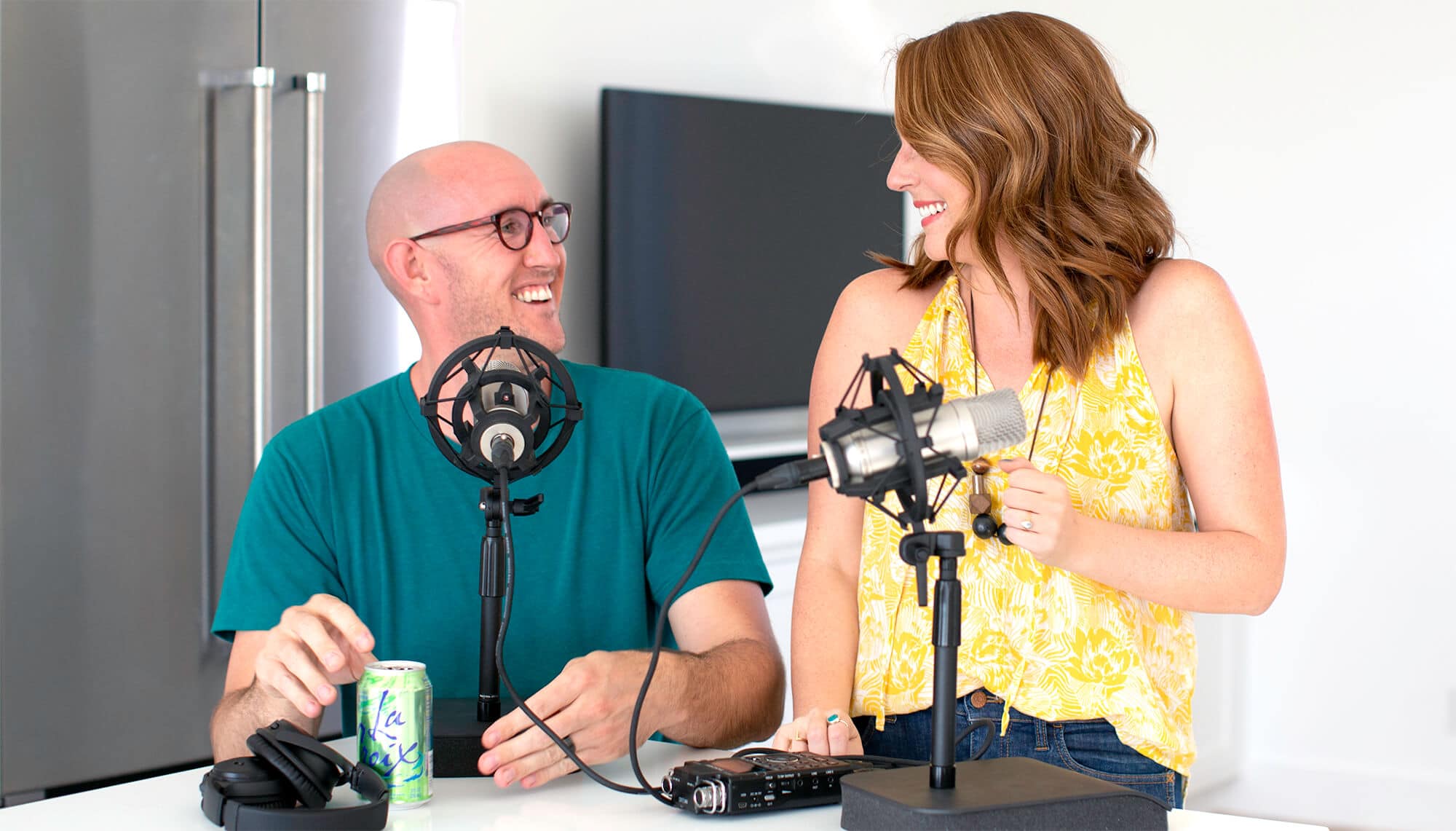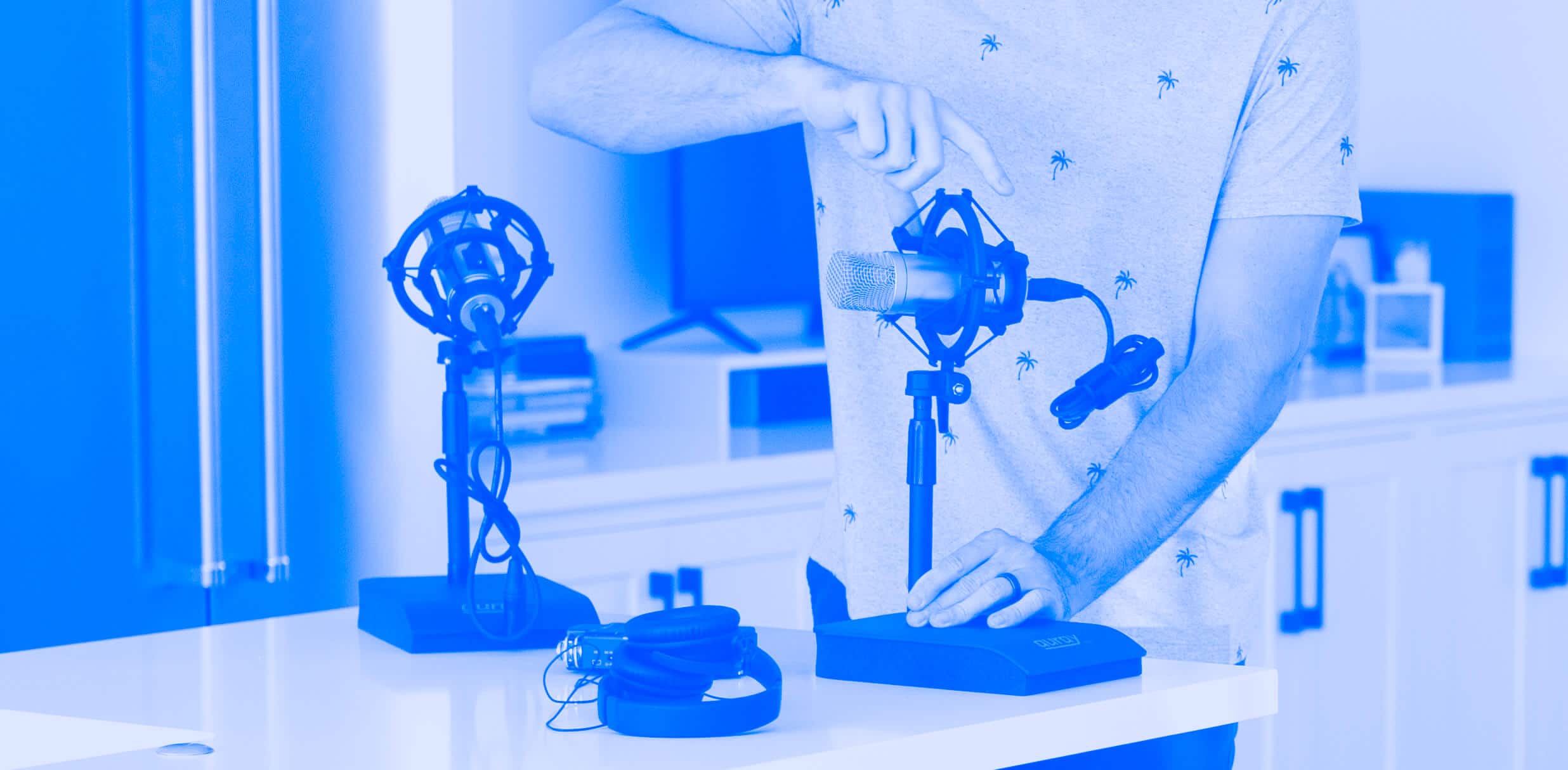Get monthly coaching and support to FINALLY gain momentum in your business without burning out in the process. 🦄 Learn more about WAIM Unlimited.




Whether your main goal for starting a podcast is to make money, have conversations with interesting people, or share your opinions on a given topic, we’ll share proven examples to take your podcast from an idea to something worth listening to.
We’re also going to answer these common questions you might be thinking right now:
Without further ado, let’s dive in!
Is there a topic or opinion that you’re dying to share? Have you spent years cultivating a skill and are looking for a place to share everything you’ve learned? Have you built a business or want to build a business and think a podcast could help you on that journey?
Podcasting is a fantastic way to get your unique message out in the world and (hopefully) in front of your target audience.
A podcast is not a place to complain about your issues with your cable provider and their lack of customer service (that’s Twitter). A podcast is not a place where you can put photos of your cute little niece Samantha (that’s Facebook). A podcast is not a place to teach people how to put IKEA furniture together, although, with some wit, that could be a highly ironic and funny podcast to listen to (you’d probably keep your IKEA videos on YouTube).
(Oh hey, this is me (Jason) and my wife Caroline just being 100% natural for this podcasting photo!)
You are most likely very familiar with trying to grow an audience using Facebook, Twitter, Instagram, etc. However, unlike social media, the experience of choosing to subscribe to a podcast is more like an email newsletter subscription (or YouTube channel subscription). If your listeners choose to subscribe to your podcast, they get notifications and downloads specifically about your show.
When you have a message worth sharing, using a podcast to broadcast your message can be very powerful. People can hear your tone. They can feel your emotions. They may not be able to see the expressions on your face, but we’ve all listened to at least one podcast episode that inspired us.
One of the first podcasts I created was a co-hosted show with my friend Paul Jarvis. We would have fairly regular Skype calls where we riffed about entrepreneurship, creativity, business, and at times zombies and vampires. We decided to see if other people might find our conversations interesting and created a podcast called Invisible Office Hours where we explored the intersection of creativity and commerce (and zombies). Invisible Office Hours kicked off in 2014 with no audience and has grown to 3,000 downloads per week many years later. We continue to see new email subscribers and new customers who’ve found us and our businesses through our co-hosted podcast. (I’ll talk more about co-hosting versus going solo in the next section.)
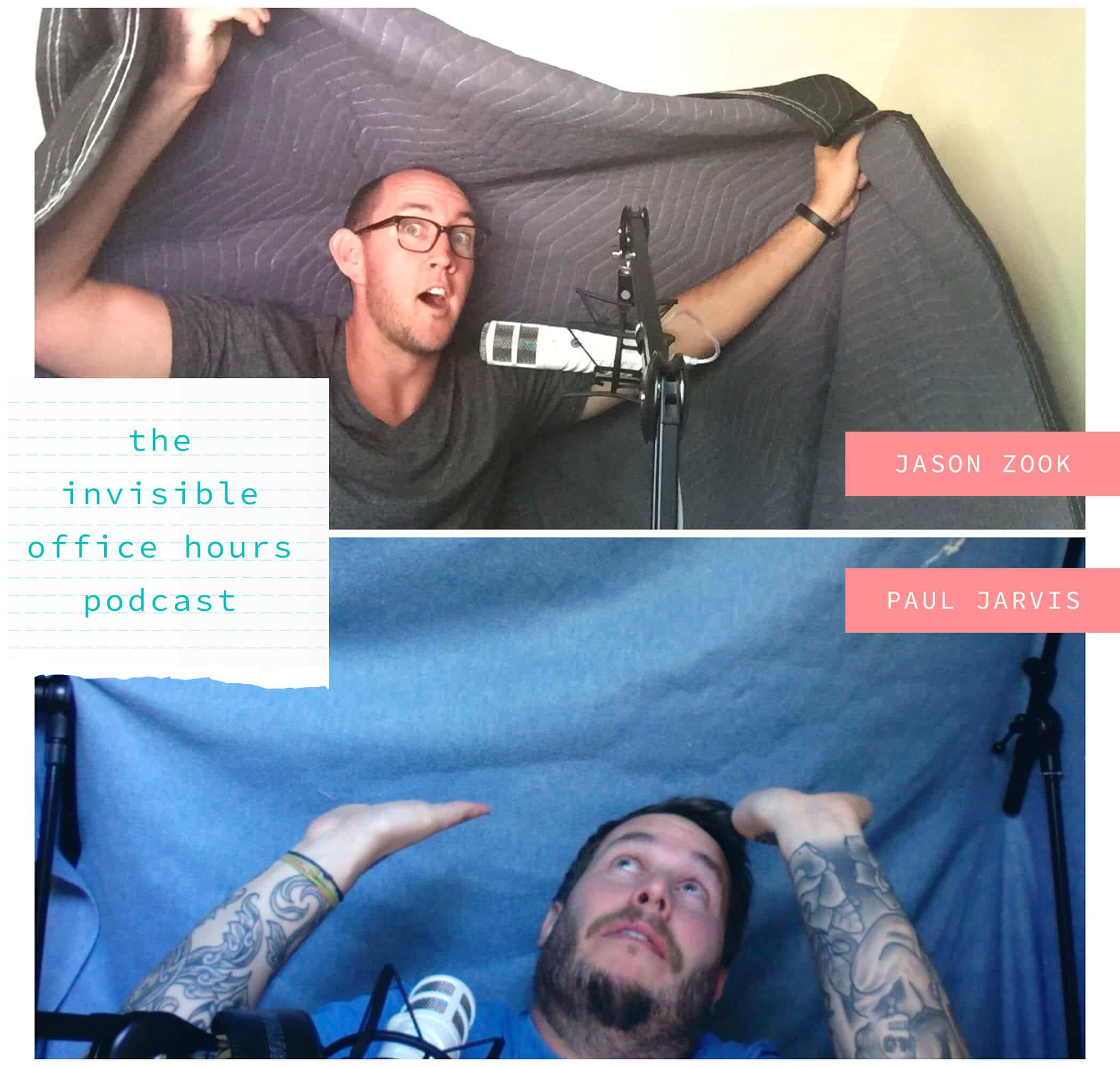
(It helps attract even more listeners if you use a “blanket fort” when recording your podcast with your co-host!)
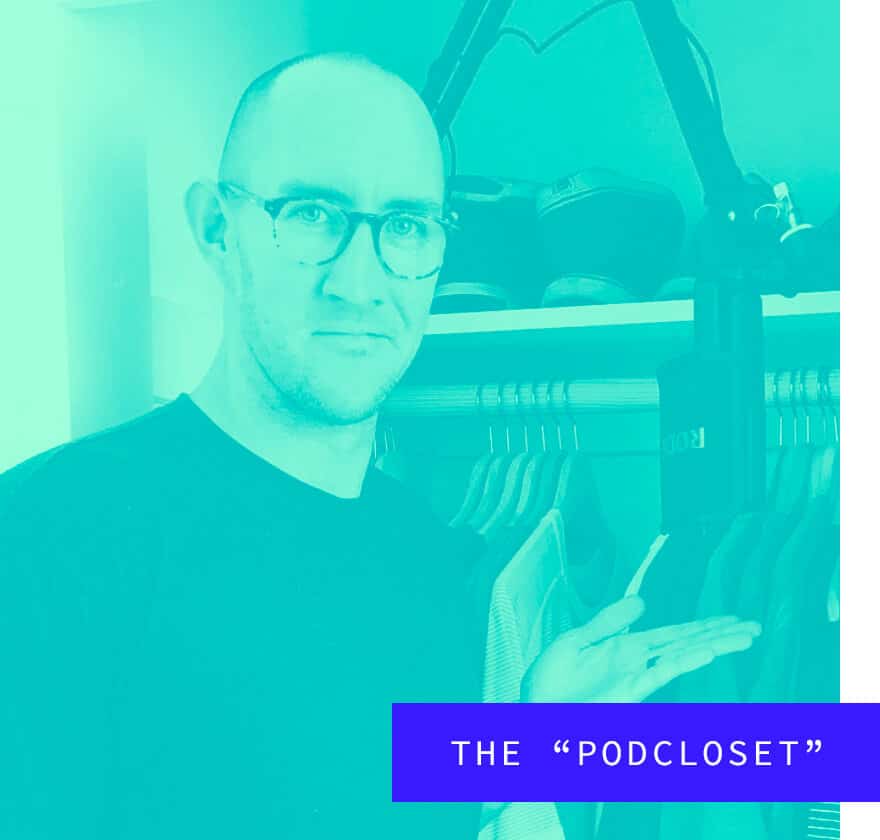
For my own podcasts over the years, I’ve thought of them as a way to deepen relationships with an audience I already have. My previous website was called JasonDoesStuff and I had an email newsletter called The Action Army. After two years of writing consistent weekly emails, I felt the urge to turn some of my thoughts into a weekly podcast. Week after week I would publish a podcast episode similar to the email topic I’d shared, but with a bit more background and silly tangents (which are much easier to accomplish in an audio format). I loved receiving emails from Action Army subscribers who listened to a podcast episode and felt a whole other level of connection to me and my writing. Those emails always made me think: Podcast Mission Accomplished!
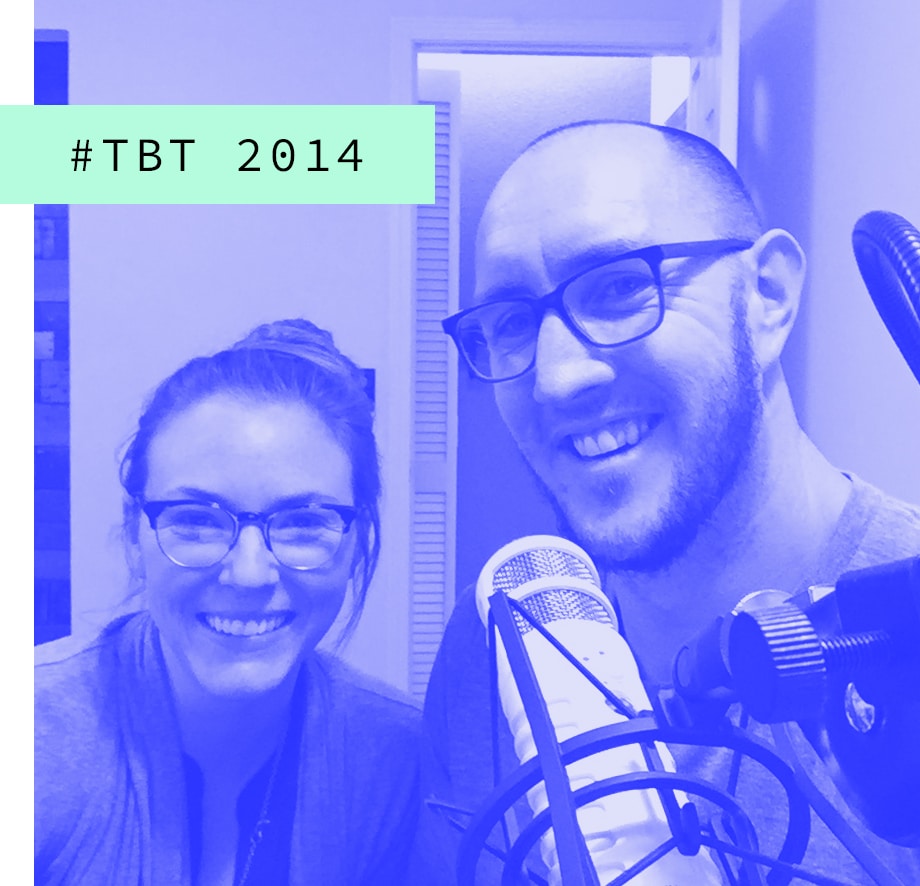
Here’s what a lot of people writing articles just like this one won’t tell you: A podcast may not get a lot of organic listenership and may just be a fun side project for you. My wife and I ran a podcast from 2014 to 2015 called Sleeping With The Boss (silly, I know). The idea of the show was to share stories of how we lived together, but also how my wife worked for and with me on my various entrepreneurial endeavors. At the “peak” of our podcast downloads, we had 200 downloads per week. Let’s just say we couldn’t attract many mattress sponsorships with those numbers. But making money with Sleeping With The Boss was never our goal, we simply wanted to share our thoughts and have a collaborative project together.
Your podcast and mine will never be as popular as Serial.
Whatever reason you have for creating a podcast, just be honest with yourself about why it exists. Your podcast and mine will never be as popular as Serial, This American Life, Revisionist History, etc. That’s okay! We don’t need Serial-type numbers to measure the success of our podcasts. We need the numbers (or lack thereof) that actually matter for our specific podcast-creation reasons.
It’s hard to say whether podcasting has hit a “bubble” yet and is too over-crowded. I believe it hasn’t and that creating a podcast is a wide-open playing field that’s gaining a lot of great attention, momentum, and is becoming more accessible than ever.
The majority of us aren’t working for NPR and won’t have a whole slew of people and audio resources at our disposal for our podcasts. Instead, we have to decide if the show we want to create can be done solo or needs a podcast co-host.
Solo podcast: If you can say everything you want on your own and feel confident in speaking situations (or just in general), then you probably do not need a podcast co-host.
Co-hosted podcast: If you find it awkward talking alone, in a closet, to only a microphone and your hanging clothes, then having a podcast co-host might be the right fit for you. I know, I know, you might not record your podcast in your closet, but if the idea of trying to talk by yourself on a podcast is overwhelming, you’ll probably want a co-host.
Pro: You call all the shots. Every single part of the podcasting process is controlled by you and no one can push back on any of your decisions (show name, episode content, format, etc). You’re the King of the podcasting castle!
Pro: Way less tech and editing involved. Having a solo podcast means you only need one microphone and editing your episodes should be a breeze.
Con: You do all the work. Sure, you can outsource podcast production (audio engineering) and other things, but the weight will most likely fall on your shoulders to record/edit/upload episodes, share and promote them, keep a recording schedule, come up with future episode topics, engage with your audience, etc. It can be done, I’m proof of that!
Con: It can feel a bit lonely in your closet. Even if you’re comfortable talking to your button-down shirts and blouses in your closet, it can get a little lonesome on the mic by yourself. But hey, maybe that’s what you’re looking for?
Pro: Someone to riff off of. From my own experience, having a podcast co-host creates a ton of extra thoughts and ideas. Plus, I’ve learned that sometimes I have way less to say then I thought on a certain topic and a co-host can swoop in and save the conversational-day.
Pro: Someone to generate ideas with. My solo podcast had 100 episodes and at certain points, it was tough to come up with new topics to discuss. On the flip side, my co-hosted podcast has had 100+ episodes and it’s never felt difficult to come up with episode topics. Oh, and it’s not just episode topics, having a co-host is great to brainstorm promoting your podcast or ways to make money with your show (if you’re into that).
Con: You’ll argue at some point, sorry. It’s just bound to happen. It may not be a big blowout brawl, but it’s natural for people to disagree when working together. Tough conversations will have to be had at some point during a co-hosted podcast journey.
Con: Quick decisions are much harder to make. When you have a podcast co-host there’s a second decision-maker who has just as much say in what you do with your show.
Con: There’s a bit more tech involved. I’ve done an in-person co-hosted show and a co-hosted show via Skype. Both have their own technical challenges and add a lot more complexity to the mix. Especially if you’re going to edit your own podcast episodes, multiple audio tracks (or voices on a single microphone) can get tricky.
Who do you effortlessly converse with? Who shares similar values to you? Who could you spend hours working with? Those are the most important questions to answer when searching for a podcast co-host.
You know when you listen to a co-hosted podcast and you just feel the chemistry the two hosts have with each other? That’s exactly what you want to strive for.
Your podcast co-host should share your same values for the best chance of long-term podcast success. You absolutely do not need to agree on everything in life, that would be a boring show, but the bigger picture items that you both believe should be in alignment. Example: Let’s say you’re a vegan, you probably don’t want to co-host a podcast with BBQ Pitmaster. That’s a recipe for disaster (heyo, food pun!).
TIP: I’d highly recommend recording and editing a few test episodes with your potential podcast co-host. How did the recording go? How was the chemistry between you? How was the division of labor to get an episode fully edited and produced? Reflect on this trial run before going all-in.
It can seem like the only way to have a successful podcast is to have an interview show. You know, like the Tim Ferriss, Magic Lessons, How I Built This, etc. But here’s the really important question you should ask yourself:
It’s easy to answer, “Be #1 on Apple Podcasts!” or “Get a bajillion downloads and have all the mattress companies sponsor my show!”
I’ve started nearly 10 podcasts since 2014 and every podcast has had its own unique goal (neither of which were goals defined by things I couldn’t control, like being #1 on Apple Podcasts or a bajillion downloads).

Are you podcasting to sell more of your products or services? This is a great reason to start a podcast, especially if you already have an existing audience and are simply trying to deepen a relationship with your people. You can measure the success of your podcast by putting a survey in the post-purchase email you send to anyone who buys things from you. Just ask them if they heard about your product or service on your podcast. If they say yes, then your podcast is successful at the thing you need it to be doing!
Are you podcasting to meet interesting and influential people? Then creating an interview-style podcast and landing guests that you admire will lead you down a clear path to podcast success. Most great interview podcasts didn’t start with the goal of climbing the Apple Podcasts charts, they started because the host wanted to have meaningful conversations with fascinating people.
Are you podcasting to scratch a creative itch? I’ve done this a few times and these podcasts have all been deemed successful if I could continuously publish new episodes and see some amount of listenership growth. When I scratched my creative itch or when I felt the urge to move onto something else, I knew this type of podcast had done its job.
Your podcast ranking on Apple Podcasts and podcast download numbers are just vanity metrics. You need to define what actual success means for your podcast.
I ran a podcasting workshop with friends who have a popular interview podcast. During that workshop, we talked about these being the common problems of running an interview-based show:
While an interview show can be an amazing way to meet and have conversations with people, there’s no doubt it’s a ton of extra work. It’s important to understand what you’ll be getting yourself into and how you can curb some of these common problems by being as prepared as possible for them.
Let’s be honest, as much as we want to blame other people for not bringing their A-game, it’s on us as the creator of our podcasts to take the initiative and do everything possible to have great interviews.
Step #1: Create a “get ready to be on the podcast” checklist. This may seem trivial, but you may encounter podcast guests who don’t have a ton of podcasting experience. Recommend a few simple things to them:
Step #2: Give your podcast guests questions ahead of time. Most people don’t like to be surprised with questions, it can make for a very uncomfortable conversation. Send an email a few weeks ahead of time with a list of questions and make sure your guest feels good about the topics you’re thinking of discussing.
Step #3: Introduce your guest separate from the interview. One of my biggest pet peeves as a frequent podcast guest is when a podcast host asks me to introduce myself at the start of the show. The first 2-3 minutes of the episode are me giving myself an awkward introduction (or worse, the guest giving me an awkward introduction and I’m forced to be there listening to it). There’s a reason why most successful interview shows do an introduction separate from the interview and it’s because it avoids any immediate awkwardness when recording starts. If you have an interview podcast, record your guest introduction AFTER the interview as it will give you a lot more context to share with your listeners.
Do your research and don’t be afraid to go off-script with your podcast guest.
I’ve been fortunate to do well over 100 podcast interviews over the years. In that time, I can count on one or two hands the interviews that were really great for me (and where I probably brought my best energy to the show!).
Tip #1 for a great interview: Do your research on your guest. As an interviewee, it’s easy to know when a podcast host just wrote down a list of topics and didn’t do much research on them. It forces the guest to feel like they have to overexplain things which leads to a less-than-stellar experience. Podcast hosts like Tim Ferriss do a great amount of research on their guests and it shows in the quality of questions being asked.
Tip #2: Avoid phone interviews. This doesn’t seem to be the norm anymore, but I rarely spend time talking on my phone and it’s not going to give great audio quality. Use Skype, Zoom, Zencastr, or some other service (more on these services in Section #4: Podcasting Gear).
Tip #3: Be willing to go off-script. My least favorite interviews I’ve ever done are the ones where I feel like I’m answering a list of questions, none of which relate the answers I give. Here’s an example:
My absolute favorite interviews are the ones where a podcast host may have 5-6 topics to discuss ahead of time, but we may go really deep on one topic and never get to the other ones because our conversation ended up being so great and natural.
(As an aside, I actually like “lightning round” questions at the end of an interview. Those are where you can ask about unrelated topics because it feels like the answers can be quick and my brain is ready for it.)
Tip #4: Don’t badger your guest to share their episode. One of my least favorite podcast host moves is when I get an email asking me to share the episode with my email list or social media followers. I’m a big proponent of asking people to share work, but it’s all in HOW you make that pitch. The ask needs to be courteous and there needs to be zero pressure at all. Bonus points if you make well-designed shareable graphics, short audio/video clips, and have all the links easy to copy and paste.
When you’re getting started, it will be an uphill battle to land notable guests for your podcast. Just understand this and be okay with it.
Many podcasters want to have high-profile guests on their podcast before they get their bearings and get comfortable hosting their show. Would you rather have Elon Musk on your podcast when you’re just getting started and don’t have all the kinks ironed out? Or would you rather wait until you’ve hit your groove, have the technical side of things down, and feel much more confident? (Feel free to replace Elon with your podcast guest of choice!)
You’d be shocked who your friends know. You may not think your 180 friends on Facebook know anyone worth having on your podcast, but I bet you’d be surprised. In fact, I know you’d be surprised! Your existing connections, whether it’s friends on Facebook, contacts in your phone, email contacts, etc, are folks who trust you and would be willing to introduce you to their friends. Start with who you already know (and how they might know) and don’t be afraid to have a lesser-known guest on your show early on.
It’s wayyyyy easier to book someone for your podcast if you can see them showing up on lots of other podcasts. That person is probably in some sort of promotion/marketing-mode and will be way more willing to say yes to your interview request (especially if you have a newer podcast). Reach out to the prospective guest via email or social media and do a little extra work to listen to their other interviews and offer up an angle for your show that will be different and may excite them.
One of the best ways to land a podcast guest is to attend meetups or conferences. For me, when I used to do a lot of public speaking and would come off the stage and get asked face-to-face to be on someone’s podcast, I was almost always said yes. There’s a much stronger connection when you talk in person and can create a bond right away. Don’t just seek out the speakers at events either, see if you can find interesting people attending the events who might be great interviewees.
I’ve been sent a small handful of good cold emails to be on someone’s podcast who I didn’t know. Here are the exact things that always stood out to me with these email requests:
If you’re sending cold emails to prospective guests, don’t forget to send follow-up emails! I’ve written an entire article on the secret art of follow-up emails and would highly recommend reading that.
Especially for higher profile guests, if you can put in the time and effort to support them and show up often (on Twitter, FB, YouTube, replying to emails they send, etc) without making an immediate ask, you’ll have way more luck down the road. This is a tactic reserved for podcast hosts that want to build a genuine relationship with someone and not just have them as a notch in their podcast guest belt.
Do not: Badger people on social media. It’s one thing to show up in conversations, like tweets, comment on posts, etc. It’s another thing to constantly be pitching your show to someone.
Do not: Send copy + pasted emails. I’ve received so many emails from podcast hosts and I can tell it’s a boilerplate email with my name swapped out. People’s bullshit radar is high for generic outreach these days. Don’t just copy + paste.
Do not: Put a podcast guest on the spot. This is one of my least favorite tactics podcast hosts use. You’ll finish an interview, and then the host asks, “hey, do you have one awesome person you’d introduce me to have on the show?” It’s just not comfortable to be asked that question on the spot and feels weird. This is okay to do in a follow-up email after the show episode has aired, but don’t do it right after the interview.
Do not: Get angry if someone says “no” to be on your show: I’ve only had this happen a few times, but I’ve been in a “no-mode” while working on a big project. I’ll say “no” to being a guest on someone’s show and they’ll get angry. Respect other people’s time and ask them when a better time circle back around and ask might be.
Heads-up: In Section #4 I have recommendations of gear and software to use if you’re running an interview podcast. So, if you were looking for that, it’s coming up in a minute!
If you’ve listened to any podcast ever you’ve probably heard the mention of sponsors or advertisers. On some podcasts, you’ll hear the hosts call out their own products (merchandise, books, software, courses, etc). There are many ways a podcast can help you generate revenue, which may be how you’re measuring the success of your show.
Let me be clear that it’s 100% okay if you do not want to make money with your podcast. Your show may just be a creative exploration, which is wonderful and you don’t have to force your podcast to make money.
That being said, if you are trying to use your podcast to generate revenue, here a few ways to do that:
I know I hear the company names MailChimp, Squarespace, Audible, Casper, and others all the time while listening to my favorite podcasts. As someone who has had quite a bit of experience with sponsorships over the years (2,000+ sponsors under my belt!), I can attest to the value of a great sponsorship relationship.
If you’re sharing a message that brings people value and you can make money promoting a company that aligns with your message, it can be incredibly beneficial to both parties.
The best sponsorship and advertising relationships require alignment. The more you can talk openly and honestly about a product or service as a sponsor of your show, the better chance you have that your listeners will check it out (and the less they’ll feel like you’re “selling out”).
What do I mean by alignment? If you had a podcast about entrepreneurship, you probably wouldn’t want to talk about sponsors like Victoria’s Secret or Yankee Candle, those companies are not aligned with your show. Instead, you’d want to try to get sponsored by Squarespace or FreshBooks. These companies offer services that could benefit your entrepreneurial-interested listeners.
You should know ahead of time that there is no standard for podcast sponsorship amounts.
I have friends who make $100 per episode on their daily podcasts. That’s $36,500 in revenue per year! Not too shabby. I know other folks who make $1,000–$2,000 per sponsorship mention in their shows. I’ve personally made $500 per episode and as high as $3,000 per episode.
The amount of money you can make with podcast sponsorships is mostly based on how many downloads your show gets AND how aligned the sponsor is with your show’s content.
Many sponsors/advertisers will want to pay on CPM-based pricing (Ex: Every 1,000 downloads = $100). I’ve never worked with a CPM-based advertiser because I’ve only ever wanted sponsors that were in direct alignment with my show’s content. That alignment allows me to charge a higher sponsorship price because the company paying me is getting a much more qualified listener. You can absolutely charge more for podcast sponsorships if you know your audience is in perfect alignment with a sponsor.
As a heads-up: I have an entire online course that teaches you how to get paying sponsors for your podcast. It’s exclusively available in our Wandering Aimfully membership.
My good friend Omar Zenhom had two failed podcasts before starting the Best of iTunes 2014 winner: The $100 MBA. Omar has been a teacher most of his life and realized his passion and teaching style would transfer well in a podcast. The $100 MBA podcast became the perfect promotional tool for a product Omar cleverly named The $100 MBA.

Omar did this with his $100 MBA podcast, pitching his own product where he also had sponsors. He also went one step further when he created an entirely new podcast called WebinarNinja. His new WebinarNinja podcast was sponsor-free because he wanted to promote a software product that would help people host webinars and master the art of webinaring (yes, I just made that word up). In the episodes of his WebinarNinja podcast, Omar would use the pre-roll, mid-roll, and post-roll spots normally reserved for a sponsor to pitch his software product.
This strategy helped Omar build an email list of folks who listened to the podcast and were interested in learning more about his webinar software (when he started the podcast the software was still being built). I love this type of marketing tactic because it lets your customers feel like they’re getting in early before anyone else.
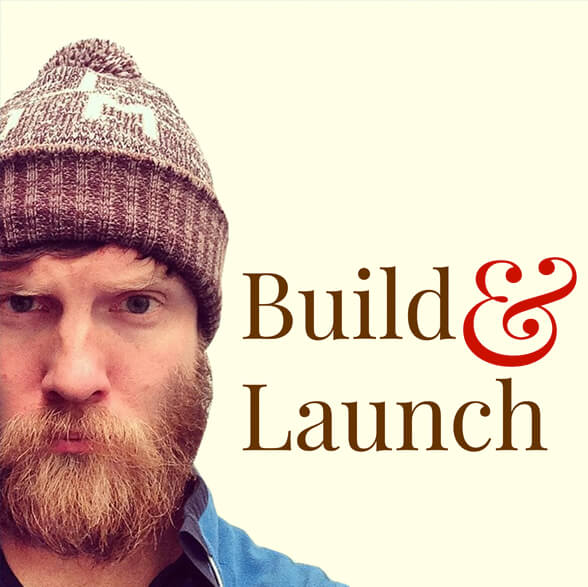
Justin Jackson is a developer, writer, and product-creating-machine. Justin has created multiple podcasts, but his Build and Launch show was an intriguing listen because he was recording episodes as he created products he wanted to sell on the podcast. Justin would share late-night sound bytes of being tired or stressed out but pushed himself to finish his work so he could sell his creations to his listeners the next episode.
Justin generated $12,049 in revenue in just two months from his Build and Launch podcast audience! Each week Justin launched a new mini-product (books, plugins, and software) to the show’s ever-growing listener base. And the great part? As his podcast grew in popularity, his new listeners could go back into previous episodes, learn about the products, and purchase them!
Think about the small time slots in your own podcast as a place to not just promote sponsors, but promote your own products and services. Maybe your entire podcast is a marketing vehicle to sell whatever it is you create?
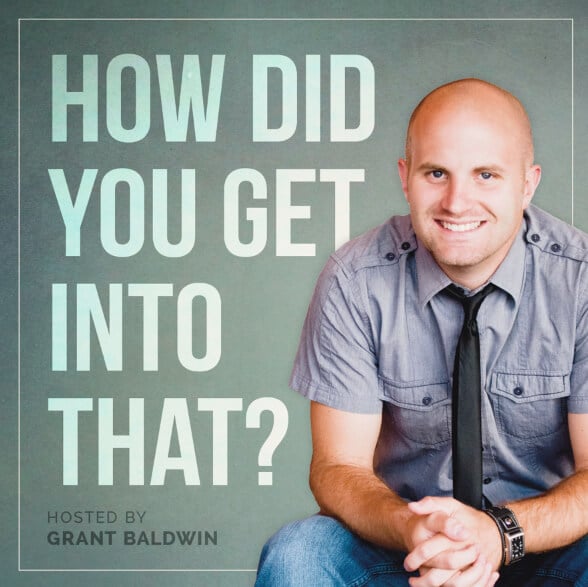
Grant Baldwin is a writer, speaker, and self-proclaimed lover of ice cream. In 2014 and 2015 while Grant wasn’t enjoying a bowl of Rocky Road, he hosted the How Did You Get Into That podcast. Grant would interview interesting people and ask questions about the start of their journeys. But, that wasn’t the only goal of Grant’s show.
Grant used his podcast as a megaphone to share when he had coaching slots available. He also constantly told his audience to get more information, downloads, etc, by joining his email list (which he could then market and promote other products to them as a subscriber).
The approach Grant used to monetize his podcast led to a spike in paid clients but also had the non-measurable benefits of networking and relationship building with the guests he had on his show.
Grant is another podcast creator with multiple podcasts under his belt. When he stopped producing the How Did You Get Into that podcast, he transitioned his efforts to a new show called The Speaker Lab. The Speaker Lab shared Grant’s experience as a public speaker and each episode helped educate a listener who might be interested in getting paid to do public speaking of their own.
Grant used the podcast as a way to sell a course and community where aspiring public speakers could learn everything they wanted to know about public speaking. Pretty smart, huh?
Having a very focused podcast topic, especially related to a skill you’ve cultivated and can teach, is a great natural fit to sell a product or service via your show.
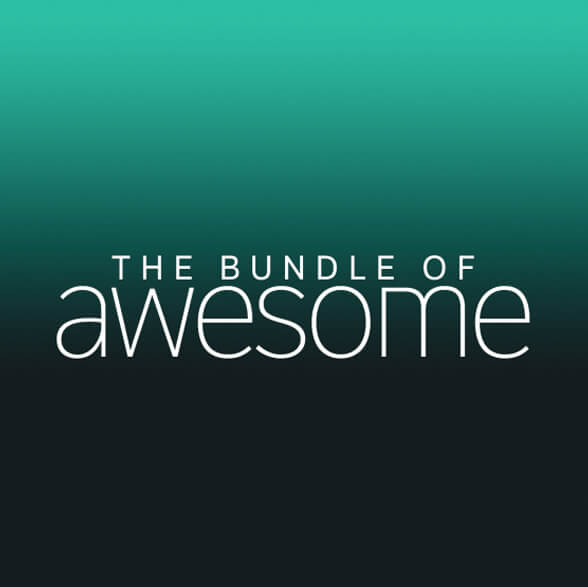
I can personally attest to making money from a podcast in multiple ways (sponsorships, selling software, etc). One of those ways was something I hadn’t seen before: A bundle of products that were sold exclusively through a podcast season.
During the second season of my co-hosted podcast, The Invisible Office Hours, my partner Paul Jarvis and I decided to bundle up 20 of our products (online courses, books, guides, WP themes, photo packs, etc) and offer them only to our podcast listeners for a limited time of 12 weeks. We called our grouping of products “The Bundle of Awesome” and sold the bundle using a pricing strategy I created called bumpsale. The price of the bundle started at $1 for the first buyer and would bump $1 after each purchase (the second person paid $2, third-person $3, etc).
Our audience was stoked to purchase a bundle that wouldn’t be offered again and could help them achieve their own goals. Plus, the bumpsale sales tactic helped keep the cost affordable and interesting!
People listen to podcasts while doing other things.
I hope you’ve realized by now I’m trying to shoot you straight when it comes to podcasting. That’s why I wanted to add a section here that acknowledges that even if you promote your own products or try to get people to join your mailing list, your listeners may not convert. Why? People listen to podcasts while doing other things.
Edison Research found that 51% of podcast listens were happening outside of someone’s home. Over 40% of people listening outside of their home were in their car, at the gym, or somehow on the move.
Do you know what’s really hard to do? Take out your credit card and make a purchase while you’re on a treadmill or sitting in traffic on the highway.
It’s important to understand that your podcast listener is probably on the move somehow. They are very likely doing another activity that will prohibit them from purchasing whatever it is you’re trying to sell via your podcast. Don’t let this dissuade you from trying to sell on your podcast, just know that you may have to keep promoting episode after episode to catch your listener at the right purchasing moment ( you know, not covered in sweat).
I’m going to skip the absolute basics of podcasting because Pat Flynn already did a great job of this. If you want to know how to title your show, what an MP3/WAV file is, or any other Podcasting 101 things, I highly recommend Pat’s article.
With that being said, here are my firsthand recommendations when it comes to podcasting gear (disclosure: many of the links are affiliate links and I make a tiny commission if you purchase using these links):
I’m going to give you the best options for no budget (free), small budget ($100), decent budget ($300), and my current recording setup ($500+). No matter which microphone you decide to use it’s almost as important to have a recording environment that will help you produce great-sounding audio.
Try to avoid recording in big open areas: No matter what microphone you use, a large open area will most likely have lots of echoes which won’t sound great. If you do have to record in a large area, try to get as close to your microphone as possible.
Record in your closet (podcloset!): Don’t be afraid to snuggle up with your hanging clothing. You can get some really solid audio quality from your closet. (This may be harder if you host an interview show, in which case, a closet may not be an option for you.)
Hang a large blanket or canvas on the wall in front of you: You want the sound behind the microphone to get absorbed as much as possible. Hang up a blanket on your wall while you record or get a piece of canvas artwork that will soak up some echo.
If you cannot spend a dollar on your podcast and you have a set of earbuds or headphones with a built-in microphone, then start here! Anything will be better than recording with your computer’s built-in microphone.
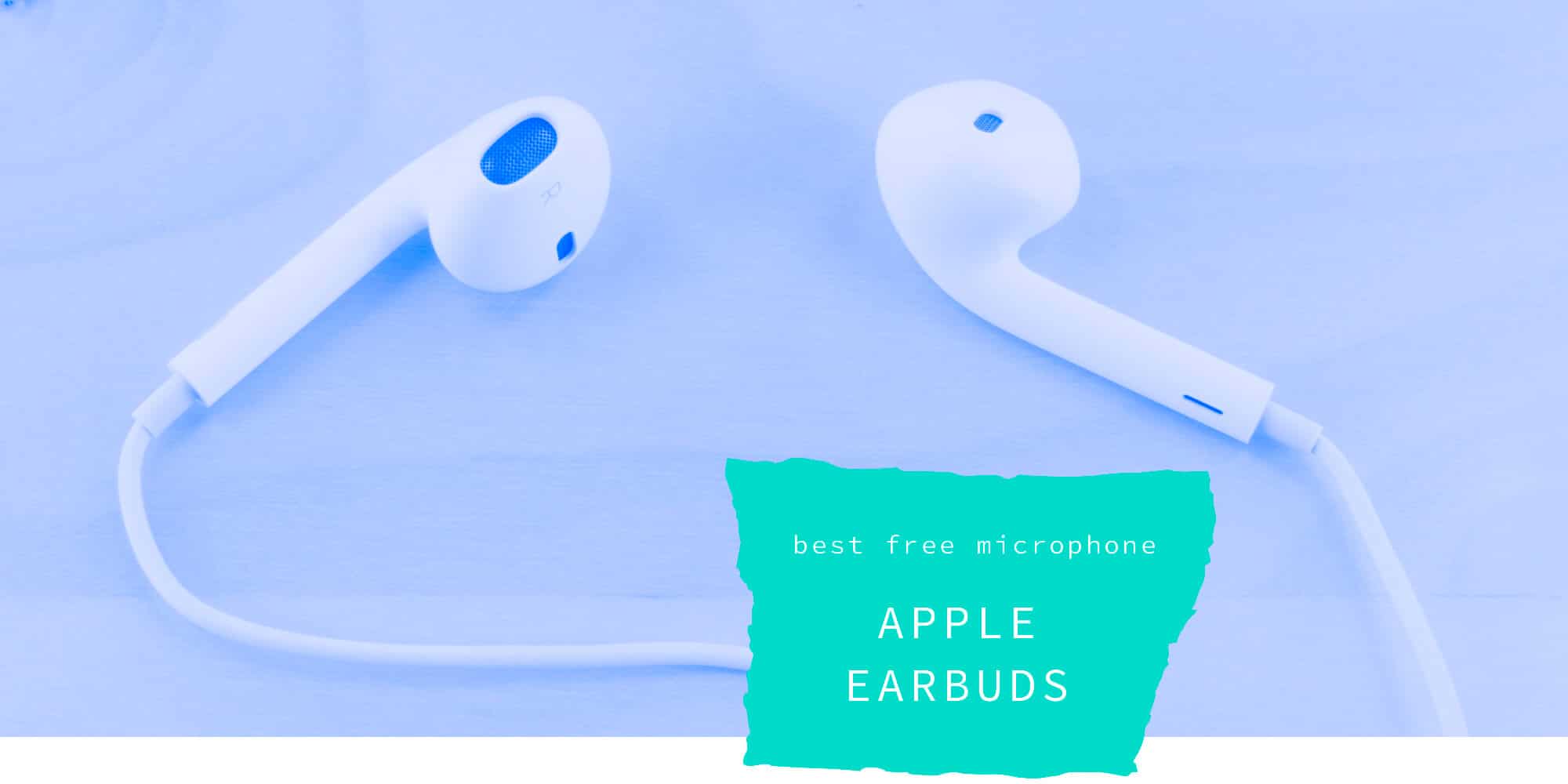
For solo podcasting: I absolutely adore the RODE SmartLav+ (lavalier) microphone. For $80ish you can capture some really solid quality audio and have a lapel microphone that can be used for various other audio recording needs. NOTE: A lav mic is best used for solo podcasting because you’ll be using the headphone jack on your computer and won’t have a place to plug in headphones/earbuds.
For co-hosted or interview shows: The Blue Snowball iCE is a verrrrry affordable option ($50ish). If you’re on a tight budget and want a great bang for your audio buck, this is definitely the option for you. Plug and play with USB, has its own small stand, and the Blue Snowball iCE is super portable.
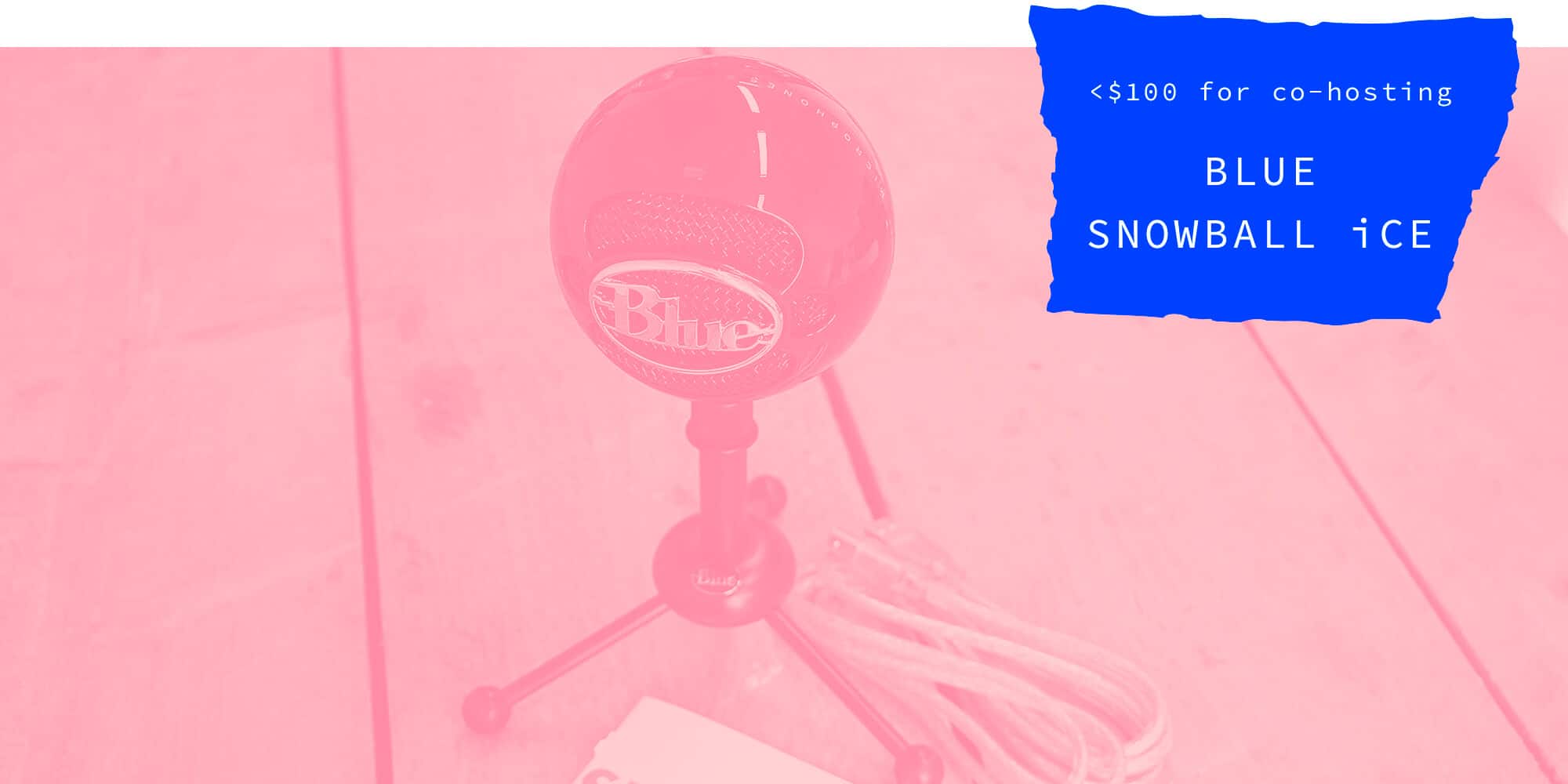
This was the audio recording setup I used for years! You can find the RODE NT-USB with swing arm for $240ish on Amazon. The swingarm can be mounted on a desk or on a shelf in your closet and the microphone can be easily moved out of the way when not in use. The RODE NT-USB is one of the best-sounding USB microphones, making it incredibly easy to plug in, hit record, and be on your way. Plus, the microphone stand and built-in pop filter are nice additional pieces of equipment that come with the microphone.
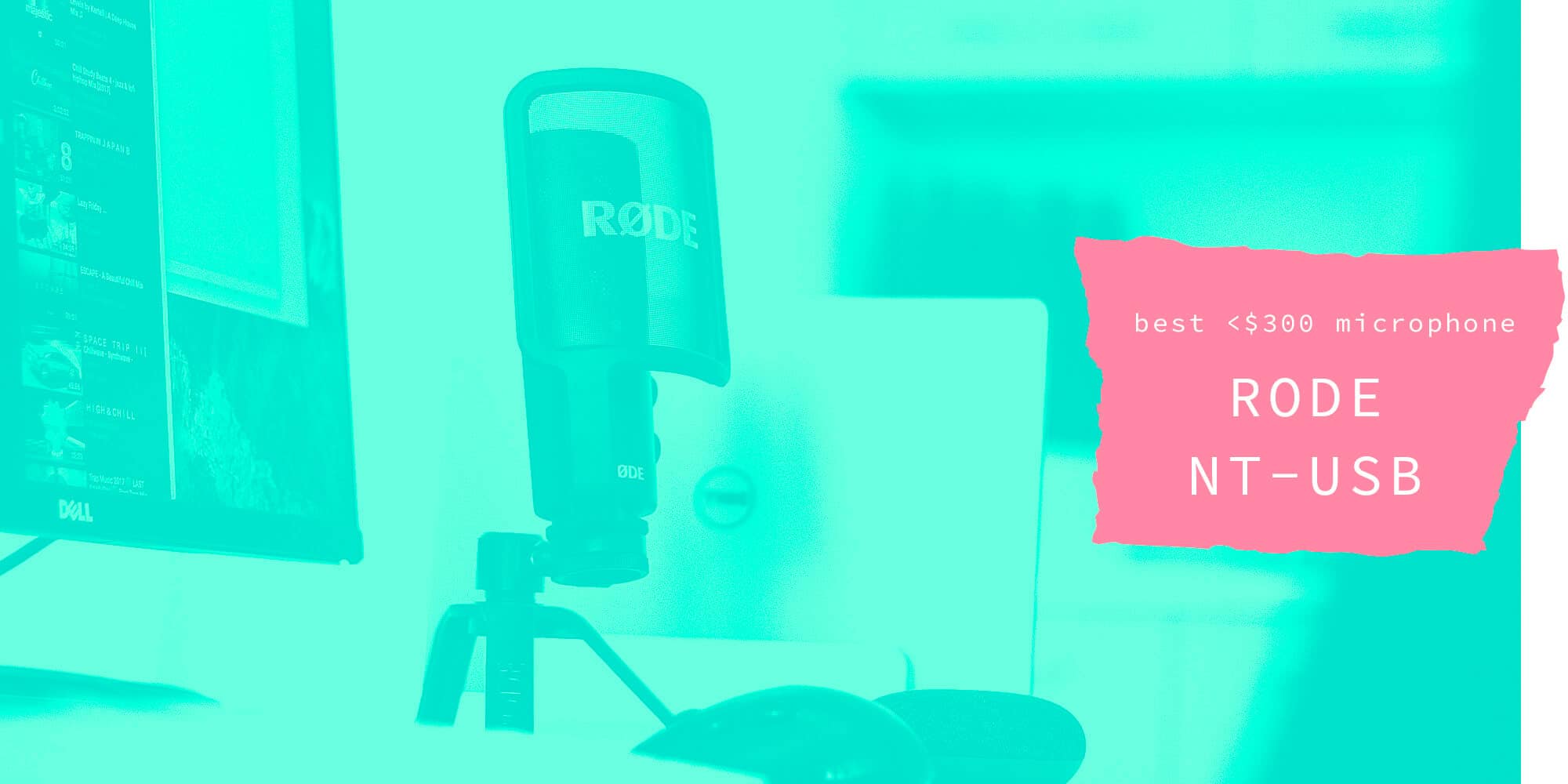
This is where you step your sound game up and get that sexy voice of yours in the ears of your listeners. I’m giving you two microphone options, but both are in the $400 range. My current recording setup is as follows:
You could swap out the RODE Broadcaster and use the Shure SM7B microphone ($399) instead (saving you $20 and giving you a sleek looking black microphone).
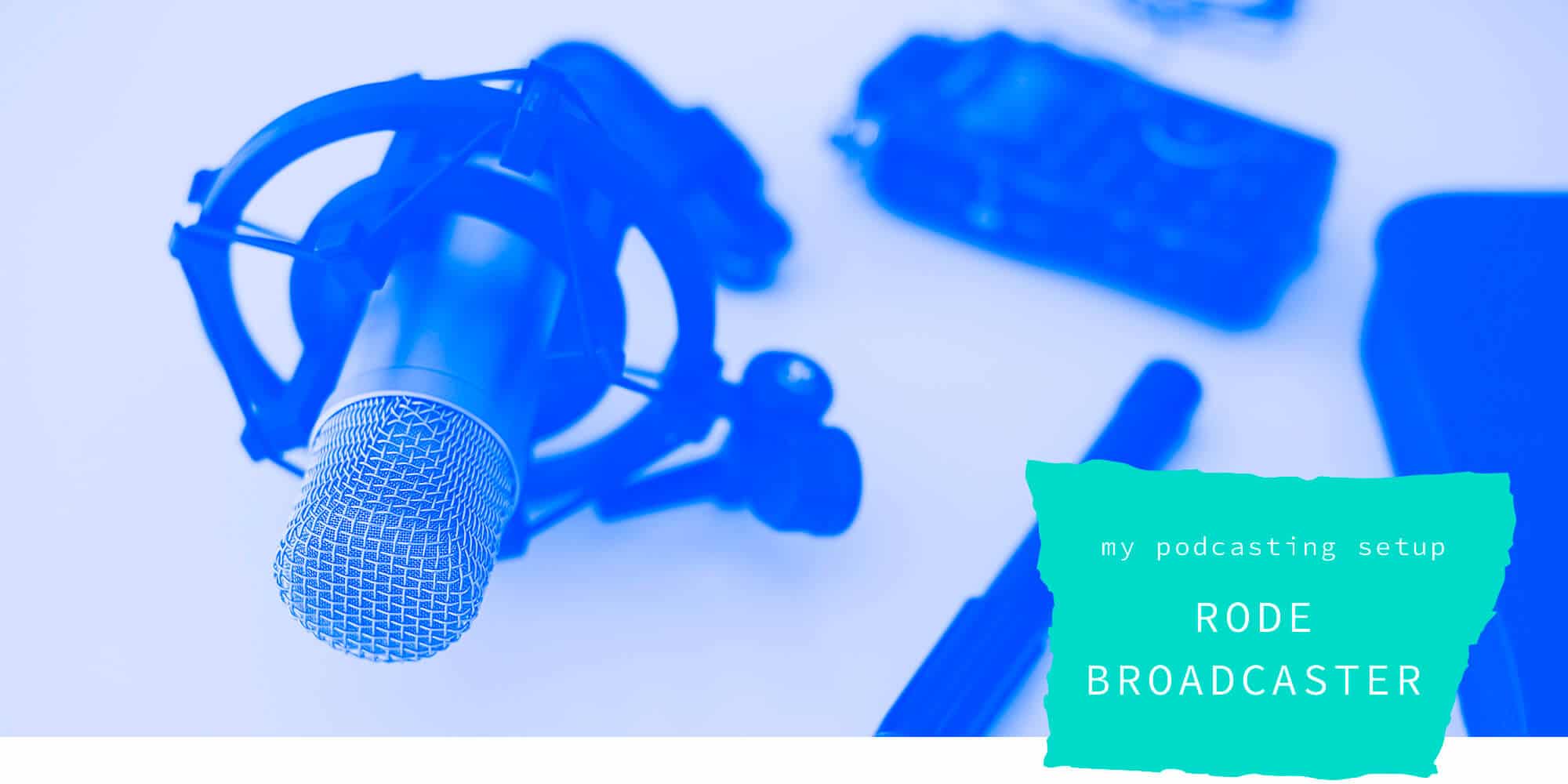
I have to preface this section by admitting that I’m an Apple user and have been since 2004. That being said, almost everything Iim sharing in this recording section is available for Windows unless otherwise noted.
I recorded over 100+ episodes of my solo podcast using just Quicktime Player. There are a handful of things you should pay attention to every time you record with Quicktime:

After much trial and error, I finally found a solid system to record a co-hosted podcast via Skype or Zoom. The premise is simple: Start your call on Skype or Zoom so that you can see yourself and your co-host (or your interviewee!). Then, both you and your co-host/interviewee will open Quicktime Player and record audio locally (as outlined in the Solo podcast instructions). Recording local audio is important and helpful because it has no bearing on your Internet connection and you get separate audio tracks which will vastly improve sound quality and editing.
I like using Skype or Zoom with video for my co-hosted podcast for a few reasons:
Using Skype or Zoom you can also record the audio of your call in case you want to have a backup. For Skype you’ll need an add-on called Call Recorder, but for Zoom there is built-in recording so you don’t have to download anything else.
The gist here: Use Skype or Zoom (which are free!) as a way to see your co-host/interviewee, but record audio separately using Quicktime (also free!) to get the best sound quality.
Bonus option: I’ve used Zencastr on multiple occasions as an interviewee of a podcast. I’ve heard great reviews, so it may be worth trying out.

My wife and I record a podcast together in our house. We used to record standing next to each other in our closet on one microphone, but have since stepped up our audio recording game.
We use two RODE Broadcaster setups (my preferred recording setup above) and plug those two microphones into a Tascam DR-100MKII audio recorder (we use the slightly older model, the Tascam DR-100MKIII is newer and fancier). This setup takes audio recording to the proverbial next level, while also keeping the recording gear itself fairly minimal. One of my favorite things about this setup is that it doesn’t require having a laptop near us, so we can focus just on the topic at hand.
Once you record a podcast episode, you’ll pull the SD card out of the Tascam, plug it into your computer, and start the audio editing adventure with clear, crisp audio.
Note: Ain’t no shame if you want to pick up a used Tascam audio recorder! I did and saved about $150.
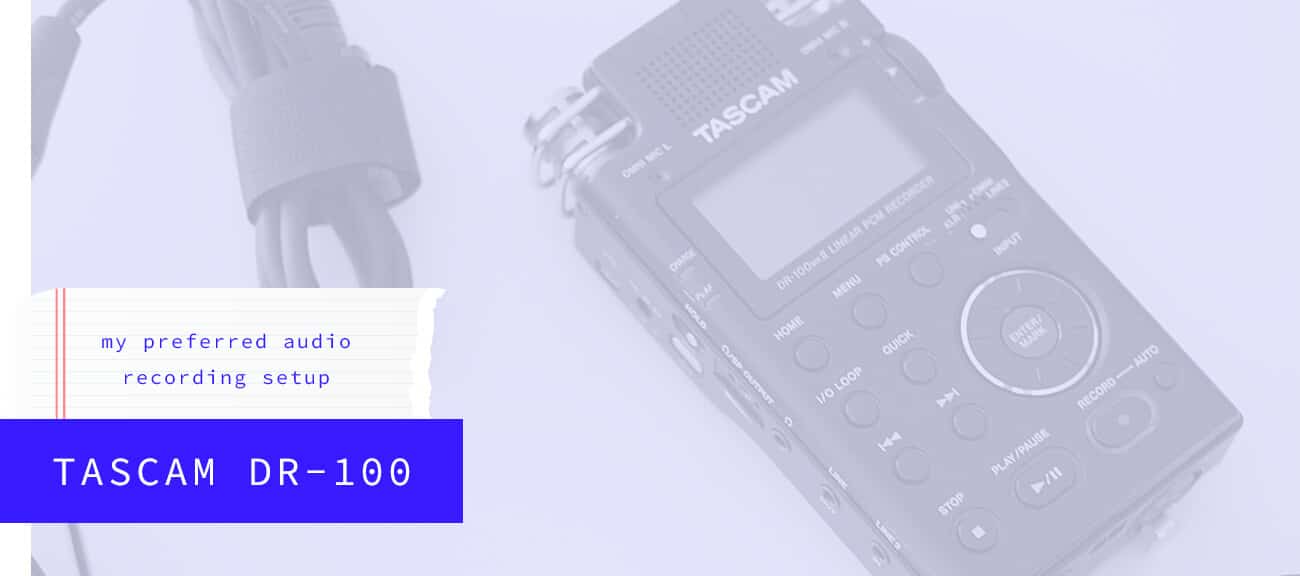
There is an infinite number of ways you can edit your podcast audio. I am NOT a professional audio engineer, but I feel like you can produce a pretty damn good podcast on your own.
GarageBand was built for this sort of thing! You can easily setup your audio track(s), separate them by music or voice, make the edits you need, and export quickly and easily. Another humungous bonus to editing audio with GarageBand is that there is a never-ending supply of free tutorial videos on YouTube to help guide you through the process!
If you’re a Windows user, Audacity is a great (free!) option with similar features and helpful tutorials on YouTube.
I used the folks at PodcastMotor.com for over a year. The process was incredibly efficient and saved me a ton of time. I’d simply record my audio, send it to the PodcastMotor folks, give them simple instructions, and a few days later I had a fully produced podcast episode for just a few bucks. How many bucks? That depends on the length of your episodes and the complexity of the production (the range could be $30 per episode up to $300 per episode).
There are many podcast production companies out there these days, but I have first-hand experience with PodcastMotor which is why I’m recommending them. Also, I don’t get any commission if you use them, so there’s no incentive for me here.
Want to support a fellow creative doing work they love? There are tons of freelance audio engineers floating around out there. You can find folks on UpWork and Fiverr, but I don’t have experience with anyone specific on those sites so I can’t make a solid recommendation.
This is another area of podcasting where you have almost too many options at your disposal. But, I’m going to give you the ONE service you should use based on my personal experience over the years.
I love Simplecast for a few simple reasons (get it?!):
I used a handful of other podcast hosts over the years and cannot say enough good things about Simplecast. There’s a reason why well-known shows like Off Camera and Armchair Expert trust Simplecast, and if it’s good enough for the big dogs, it’s good enough for the rest of us.
I feel like it’s worth noting that I do not get compensated in any way by promoting Simplecast. That’s just how great of a product they have, I want to share it with you!
I’m not going to lie to you and say these next few paragraphs are guaranteed to work. What I am going to tell you is that they worked well for me and anyone I’ve helped start and publish a new podcast in Apple Podcasts.
It’s a guaranteed window of additional promotion to the front page of whatever category your podcast fits into. This is hugely beneficial in growing your listenership early on and creating some awesome credibility for you and your podcast (especially if you’re trying to court sponsors or get your audience to tune in to your new podcast).
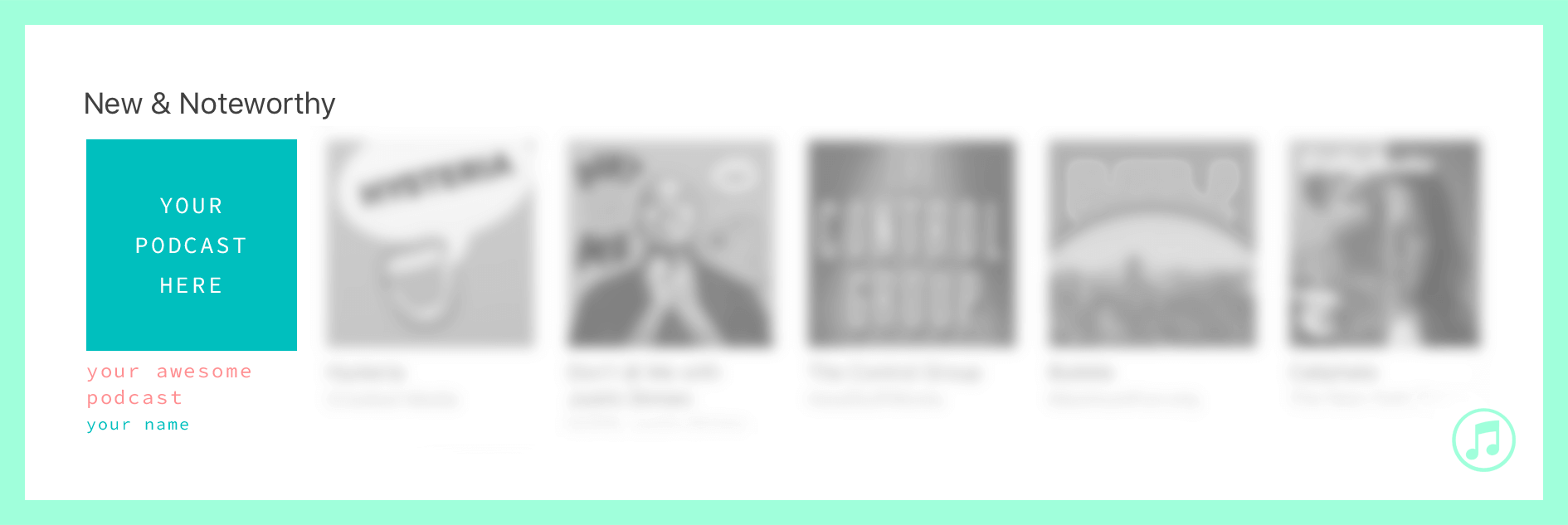
Before your podcast gets published and your episodes are live on Apple Podcasts, you should be building a list of people you can reach out to on the first day your podcast goes live. If you already have an active email list you can tap, awesome. If you don’t, start building one. You can (and should) use your existing contacts and let them know you’re about to launch a new podcast and would their help with it when it launches.
This isn’t mandatory at all, but it certainly seems to help. Why? Apple Podcasts seems to value the time spent listening to your podcast episodes. What’s going to increase that time on your launch day? Having more than one episode to listen to!
Once you submit your podcast RSS link to Apple Podcasts (via Apple Podcast Connect), it can take 2–4 days to have your podcast show up. Upload those episodes early and don’t worry if people find your show before your actual launch date. Be prepared for this! Especially as it relates to this next step…
Whether it’s on social media, your email list, or the secret society for pancake lovers that you belong to, let people know when your podcast is going live. You’ll want to pick a launch date and ensure it’s after the 2–4 day time window from Apple Podcasts. If you set a date and get people ready for it, your chances of getting them to help you with reviews (which I’ll get to in a second) and listens drastically increases. Here’s an example email/promotion schedule I’ve used to get people ready for a new podcast launch:
*Bonus: Having a podcast launch party is also a great idea! You can do it virtually through live video or in-person on your launch day.
Your podcast (with multiple episodes) is up on Apple Podcasts, it’s time to tell the world … but what do you tell them? Apple Podcasts values two things above all else: Subscriptions and Reviews.
Lots of people have never left a review on a podcast before, give them detailed instructions on how easy it can be done. You may even want to go so far as to create a “How to leave a podcast review” page on your website that includes helpful screenshots. Check out Gretchen Rubin’s example page and create something similar.
Remember that people are busy and they may need a few reminders to leave a review on your show. Those early reviews are important, so don’t be afraid to ask a few times on your launch day.
Does your podcast help people build lasting habits? Does your show debunk societal myths? Do you and your podcast host obsess over Harry Potter and break down every scene in your episodes? Tell your audience that subscribing to your podcast will help them get new episodes about habits, debunking myths, Harry Potter, etc. Just saying “go subscribe” doesn’t convince anyone or give them a compelling reason to take action.
Don’t be afraid to hunker down and send 50–100 personalized emails on your podcast launch day (pro-tip: have these written ahead of time). These personalized emails can really move the needle in getting early reviews and subscriptions for your new podcast.
Get 2-4 weeks ahead of your podcast publishing schedule.
All platforms enjoy consistent content creators. Apple Podcasts is no different. Whether you’re doing a daily, two days per week, or weekly show, make sure to stay consistent early on. Hopefully, you’ve planned ahead and are recording episodes multiple weeks in advance. This is a great habit to get into and keeps your consistent podcast publishing schedule intact.
After those six steps, it’s really out of your hands if your podcast will show up in the New & Noteworthy section in Apple Podcasts. Yes, you’ll want to share your new show on social media, but those platforms aren’t great at getting people to take action and do something (especially two things: subscribe and leave a review).
Don’t be afraid to continue to talk about your new podcast! You should definitely send another email to your audience the day after launch to remind them to keep helping you out. If you have reviews to share, those tend to encourage people who are weary about reviewing something.
If you walk away from this podcasting guide with nothing else at all, walk away with this:
Do some research into the topic you want to discuss and see who’s already discussing it. It’s not a problem if there are people already in the space—competition simply means people are already interested in that topic. What’s your unique way of talking about a certain topic? Pour as much of your own personality into your show as you can.
Yes, it’s cliché, but it rings extremely true with podcasting. Your show needs to sound good, and making that happen isn’t hard or expensive. Invest in a good microphone and either learn how to do simple audio engineering or pay a professional to do it. Invest in your show and it will pay dividends.
Good podcasts don’t stop at pushing their audio content out into the world. Good podcasts keep the experience going somewhere else and build a loyal base of fans/friends/followers.
Your podcast should be a conduit to something else. Whether that’s an email list, your website, your business, etc. Who knows how long Apple Podcasts is going to be the king of the podcasting space. If you rely heavily on Apple Podcasts and they make an algorithm change (or just get rid of podcasting), you don’t be want to be up the creek without a paddle.
